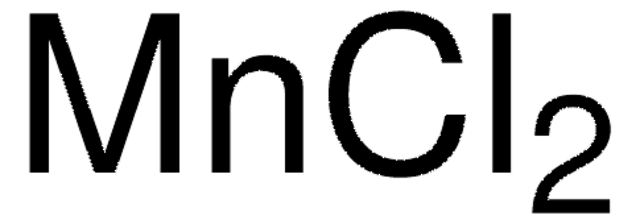M3634
Mangan(II)-chlorid Tetrahydrat
ReagentPlus®, ≥99%
About This Item
Empfohlene Produkte
Qualitätsniveau
Produktlinie
ReagentPlus®
Assay
≥99%
Form
powder
pH-Wert
3.5-6 (25 °C, 50 g/L)
mp (Schmelzpunkt)
58 °C (lit.)
SMILES String
Cl[Mn]Cl.[H]O[H].[H]O[H].[H]O[H].[H]O[H]
InChI
1S/2ClH.Mn.4H2O/h2*1H;;4*1H2/q;;+2;;;;/p-2
InChIKey
CNFDGXZLMLFIJV-UHFFFAOYSA-L
Suchen Sie nach ähnlichen Produkten? Aufrufen Leitfaden zum Produktvergleich
Allgemeine Beschreibung
Anwendung
- As a promoter to synthesize dihydropyrimidin-2(1H)-ones by the condensation of aldehyde, β-dicarbonyl compounds, and urea under microwave conditions.
- As a catalyst to synthesize dihydro-2-oxypyrrole derivatives via one-pot four-component domino condensation of dialkyl acetylenedicarboxylate, formaldehyde, and amines.
- To synthesize active manganese oxide with potential application as an oxidant in organic synthesis.
Rechtliche Hinweise
Signalwort
Danger
H-Sätze
Gefahreneinstufungen
Acute Tox. 3 Oral - Eye Dam. 1 - STOT RE 2
Zielorgane
Brain
Lagerklassenschlüssel
6.1D - Non-combustible acute toxic Cat.3 / toxic hazardous materials or hazardous materials causing chronic effects
WGK
WGK 2
Flammpunkt (°F)
does not flash
Flammpunkt (°C)
does not flash
Analysenzertifikate (COA)
Suchen Sie nach Analysenzertifikate (COA), indem Sie die Lot-/Chargennummer des Produkts eingeben. Lot- und Chargennummern sind auf dem Produktetikett hinter den Wörtern ‘Lot’ oder ‘Batch’ (Lot oder Charge) zu finden.
Besitzen Sie dieses Produkt bereits?
In der Dokumentenbibliothek finden Sie die Dokumentation zu den Produkten, die Sie kürzlich erworben haben.
Kunden haben sich ebenfalls angesehen
Unser Team von Wissenschaftlern verfügt über Erfahrung in allen Forschungsbereichen einschließlich Life Science, Materialwissenschaften, chemischer Synthese, Chromatographie, Analytik und vielen mehr..
Setzen Sie sich mit dem technischen Dienst in Verbindung.








